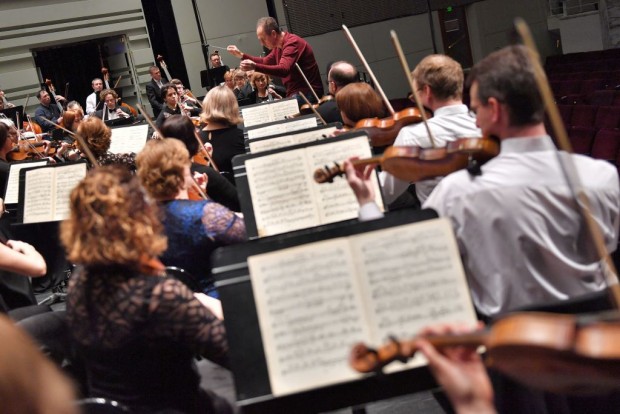Sat in front of an impressively sized ensemble during a classical music concert, you might have noticed the sheer number of violinists in the orchestra pit. Comprising two sections, "first violins and "second violins," the collective size of these instrumentalists overshadows that of any other group within the orchestra.
Standard within any symphony orchestra, the string section usually has ten first and second violins, ten violas, eight cellos, and six double basses, totaling up to 44 string instrumentalists which is almost half of the entire ensemble.
But, the question is: why so many? The answer has both historical and sound-related reasons.

Russian director Dmitri Liss directs musicians of the Ural Philharmonic Orchestra (Orchestre Philharmonique de l'Oural) during a rehearsal of a musical piece composed by Russian composer Sergei Rachmaninoff on the first day of "La Folle Journee de Nantes" classic music festival, on January 31, 2018 in Nantes, western France.
The Acoustic Reasoning
When it comes to acoustics and the economy of sound within an orchestra pit, violins simply have to compete to be heard against louder sections like the brass, woodwind, and percussion.
For this reason, professional orchestras of today often employ lightweight blockades like perspex screens to dampen the power of the loud sections away from lighter sections like the violins. To add, many musicians also wear specialized earplugs that let them hear what their colleagues are playing without having to blow both eardrums in the pursuit of doing so.
Put simply, the sounds produced by a violin are quieter than other instruments in an ensemble but in exchange they can perform more melodic passages within a composition. This is also the reason why there are two sections of violins; one plays the main melody and the second plays the counter-melody.
Violins are also the highest-pitched among the string section, with their bright tone being easier to recognize. All of these qualities make violins the most important part of any orchestra, thus warranting the numbers, at least the balance would ideally be 2 violins per woodwind or brass instrument.
The Historical Reasoning
Throughout history, violins have proven to be the favorite among classical musicians. All the way back to the Baroque period, violins were already a mainstay within orchestral compositions. That said, Baroque-focused orchestras are usually smaller and much more string-oriented.
During the 1700s, the lead within the first violin sections would even instruct the entire ensemble. This role is akin to that of the modern-day conductor and is honored today through a custom involving an orchestra leader or concertmaster who is in charge of the ensemble's tuning.
Progressing to the Romantic and 20th-Century era of music, brass and wind sections became more popular due to composers like Wagner, Mahler, and Stravinsky writing pieces that incorporated a more varied range of instruments. Because of this ensembles had collectively become much louder and orchestras needed more strings, therefore needing more violins.
Read More: 'Cradle Song': the True Lyrics and Story Behind Johannes Brahms' Iconic 'Lullaby'



